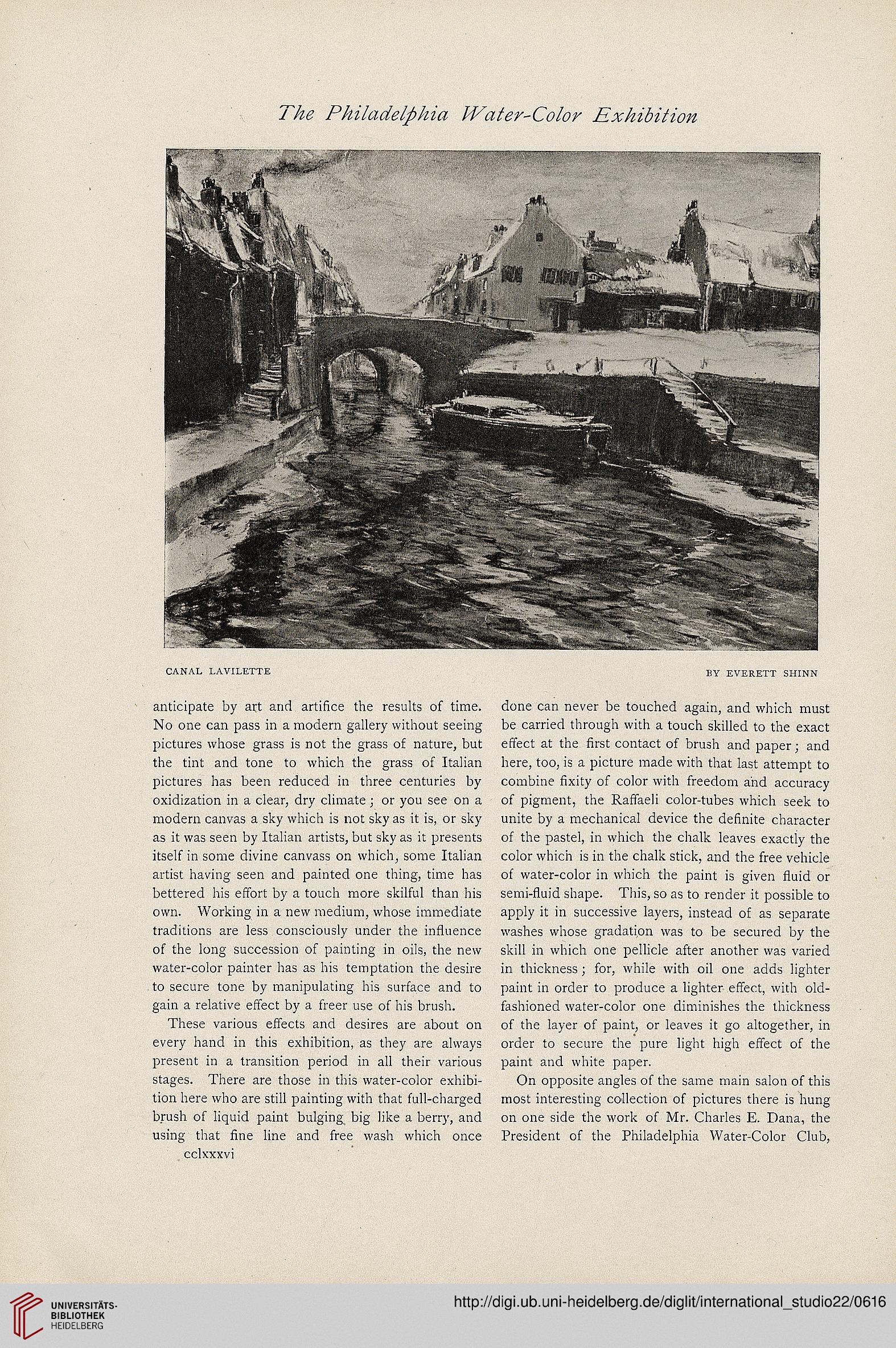7
CANAL LAVILETTE
BY EVERETT SHtNN
anticipate by art and artifice the resuits of time.
No one can pass in a modern gallery without seeing
pictures whose grass is not the grass of nature, but
the tint and tone to which the grass of Italian
pictures has been reduced in three centuries by
oxidization in a clear, dry climate ; or you see on a
modern canvas a sky which is not sky as it is, or sky
as it was seen by Italian artists, but sky as it presents
itself in some divine canvass on which, some Italian
artist having seen and painted one thing, time has
bettered his effort by a touch more skilful than his
own. Working in a new medium, whose immediate
traditions are less consciously under the influence
of the long succession of painting in oils, the new
water-color painter has as his temptation the desire
to secure tone by manipulating his surface and to
gain a relative effect by a freer use of his brush.
These various effects and desires are about on
every hand in this exhibition, as they are always
present in a transition period in all their various
stages. There are those in this water-color exhibi-
tion here who are still painting with that full-charged
brush of liquid paint bulging big like a berry, and
using that fine line and free wash which once
cclxxxvi
done can never be touched again, and which must
be carried through with a touch skilled to the exact
effect at the first contact of brush and paper; and
here, too, is a picture made with that last attempt to
combine fixity of color with freedom and accuracy
of pigment, the Raffaeli color-tubes which seek to
unite by a mechanical device the definite character
of the pastel, in which the chalk leaves exactly the
color which is in the chalk stick, and the free vehicle
of water-color in which the paint is given fluid or
semi-fluid shape. This, so as to render it possible to
apply it in successive layers, instead of as separate
washes whose gradation was to be secured by the
skill in which one pellicle after another was varied
in thickness ; for, while with oil one adds lighter
paint in order to produce a lighter effect, with old-
fashioned water-color one diminishes the thickness
of the layer of paint, or leaves it go altogether, in
order to secure the pure light high effect of the
paint and white paper.
On opposite angles of the same main salon of this
most interesting collection of pictures there is hung
on one side the work of Mr. Charles E. Dana, the
President of the Philadelphia Water-Color Club,
CANAL LAVILETTE
BY EVERETT SHtNN
anticipate by art and artifice the resuits of time.
No one can pass in a modern gallery without seeing
pictures whose grass is not the grass of nature, but
the tint and tone to which the grass of Italian
pictures has been reduced in three centuries by
oxidization in a clear, dry climate ; or you see on a
modern canvas a sky which is not sky as it is, or sky
as it was seen by Italian artists, but sky as it presents
itself in some divine canvass on which, some Italian
artist having seen and painted one thing, time has
bettered his effort by a touch more skilful than his
own. Working in a new medium, whose immediate
traditions are less consciously under the influence
of the long succession of painting in oils, the new
water-color painter has as his temptation the desire
to secure tone by manipulating his surface and to
gain a relative effect by a freer use of his brush.
These various effects and desires are about on
every hand in this exhibition, as they are always
present in a transition period in all their various
stages. There are those in this water-color exhibi-
tion here who are still painting with that full-charged
brush of liquid paint bulging big like a berry, and
using that fine line and free wash which once
cclxxxvi
done can never be touched again, and which must
be carried through with a touch skilled to the exact
effect at the first contact of brush and paper; and
here, too, is a picture made with that last attempt to
combine fixity of color with freedom and accuracy
of pigment, the Raffaeli color-tubes which seek to
unite by a mechanical device the definite character
of the pastel, in which the chalk leaves exactly the
color which is in the chalk stick, and the free vehicle
of water-color in which the paint is given fluid or
semi-fluid shape. This, so as to render it possible to
apply it in successive layers, instead of as separate
washes whose gradation was to be secured by the
skill in which one pellicle after another was varied
in thickness ; for, while with oil one adds lighter
paint in order to produce a lighter effect, with old-
fashioned water-color one diminishes the thickness
of the layer of paint, or leaves it go altogether, in
order to secure the pure light high effect of the
paint and white paper.
On opposite angles of the same main salon of this
most interesting collection of pictures there is hung
on one side the work of Mr. Charles E. Dana, the
President of the Philadelphia Water-Color Club,




